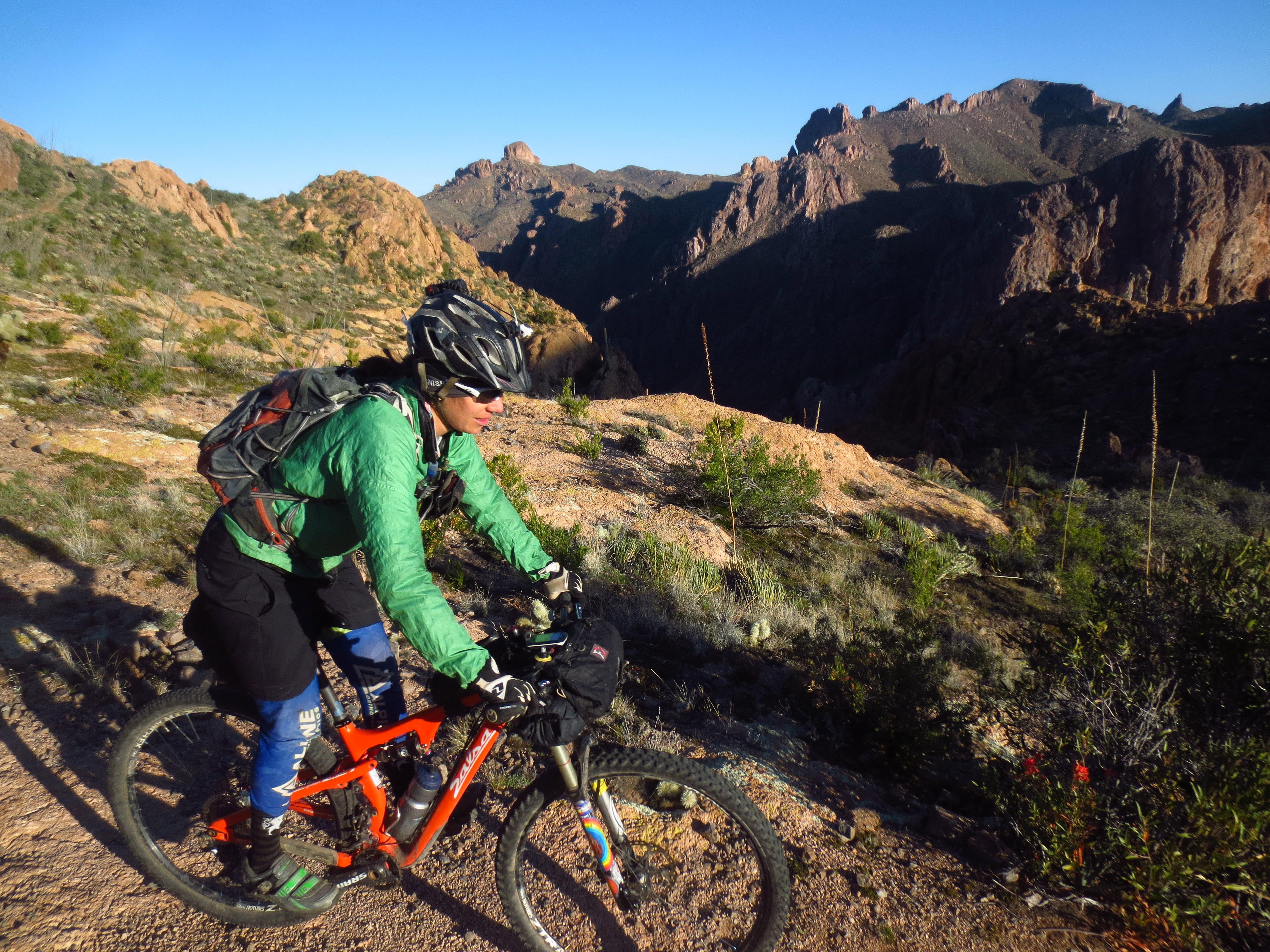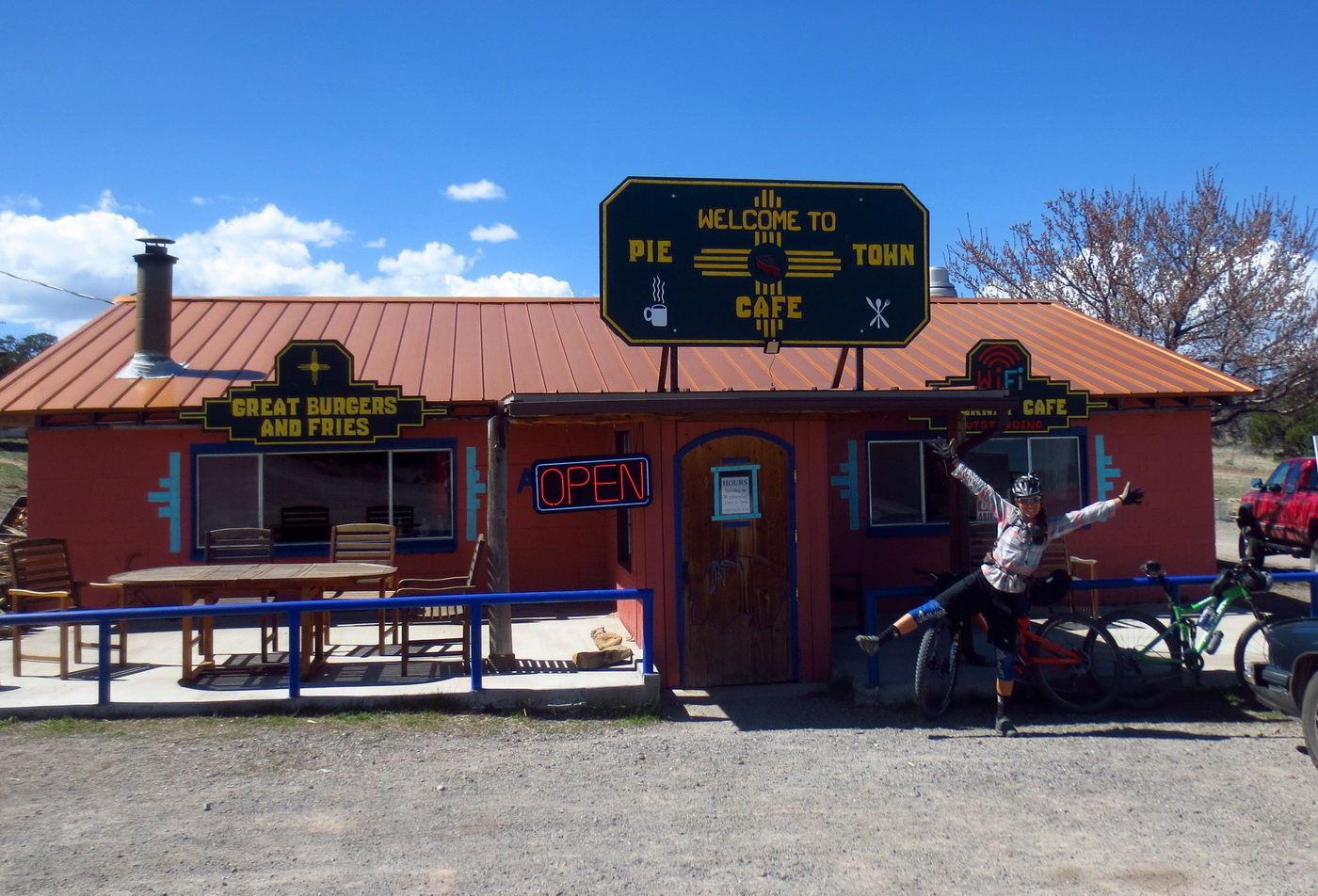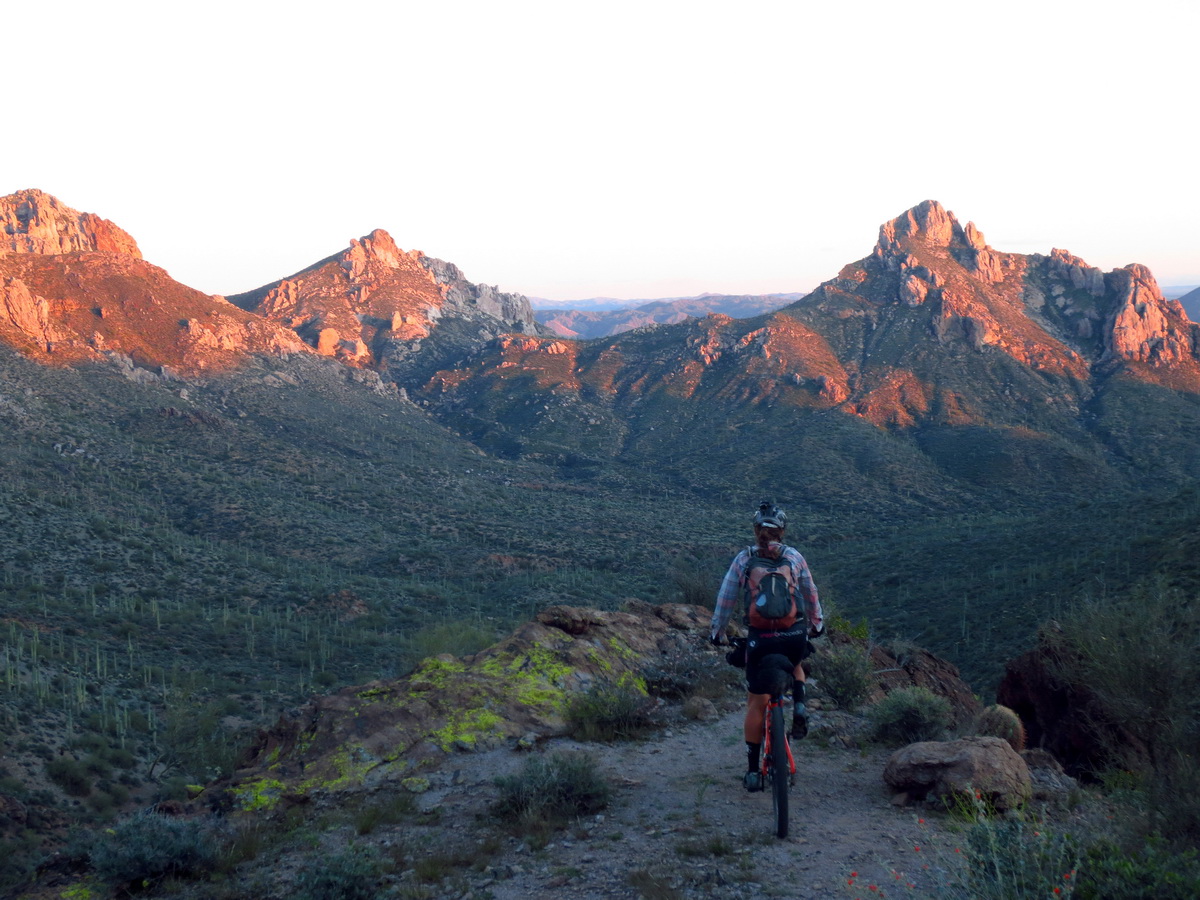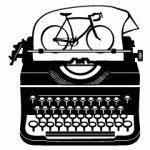
Eszter Horanyi and Scott Morris at the start of their 4,000 mile Continental Divide Trail ride. Photo via topofusion.com.
The Tour Divide is a 2,745 bikepacking race from Banff, Canada to the Mexican border in Antelope Wells, New Mexico along the Great Divide Mountain Bike Route. When Eszter Horanyi set the women’s course record of 19 days, 3 hours in 2012, she did so by averaging over 140 miles each day and sleeping just a few hours each night. Doing so on repeat for the better part of a month is a brutal challenge that pushes athletes to their mental and physical limits. It turns out Horanyi is really good at it. Over her years of bikepacking racing, she’s held or still holds records on the Tour Divide, Arizona Trail Race 300, Colorado Trail Race, Arrowhead 135, and plenty more. She stopped racing in 2013, but continues to explore mountains and valleys and remote roads by bike. I spoke to Horanyi about her entry into mountain bike racing, her bikepacking racing “career,” the self-empowerment the comes from adventuring alone, the growth of bikepacking, and more.
How did you get into mountain biking in the first place?
I was a swimmer who wanted to do triathlons. Then I decided swimming was dumb and bikes were awesome. I was racing for the University of Colorado cycling team. They desperately needed girl mountain bikers and there was a cute boy and it didn’t take much to convince me to learn how to ride a mountain bike.
When did you first try bikepacking or bikepacking racing?
Back in 2004, I was sitting in a coffee shop and read an article on the Colorado Trail. This was way before bikepacking really took off. I think maybe GDMBR was going, but there wasn’t much off-road bikepacking going on. My boyfriend at the time and I were like, let’s go ride our bikes on the trail! I’d never been backpacking let along bikepacking. We bought some panniers and futzed our way through the Colorado Trail. It was a bit of a disaster, but we finished it and I was definitely hooked.
I raced the Colorado Trail in 2010. I got talked into doing that because it seemed better than working at the time.
Tell me about the progression over those six years from the first bikepacking adventure to getting into racing.
I was riding a lot. I loved mountain biking and was doing a lot of cross country races. Then I did some 100 milers. I was pretty good at them so I did bunch of those. I did a couple 24 hour races. The Colorado Trail came at the end of a not-so-good race season. I thought, I’ve got nothing else to do, might as well go do this and see what happens. I was racing a bunch during that time, but not even thinking about bike touring before the Colorado Trail race. I definitely came to bikepacking racing from a racing background, not a bike touring background.

The views tend not to suck when bikepacking. Photo courtesy Eszter Horanyi.
Interesting. In your experience with your fellow racers, is one more common than the other?
I don’t know. Especially among women, you don’t get that many girls who are entrenched in traditional racing who then get into bikepacking. When you do a bikepacking race your recovery time is so stinking long. If you do Tour Divide your season’s done, you’re not racing anything after that. I think that if you’re a racer who enjoys racing and the scene and hanging out with your friends every weekend, it’s really hard to do a bikepacking race because you have to give that all up.
Have you been able to turn cycling and adventuring into a full time job?
I wish! No. It never has been unfortunately. I haven’t really raced much since 2013. I did the Iditarod Trail Invitational and the Arizona Trail Race within a month of each other. I tore my quadricep tendon and got tendonitis in my hamstring. Then once that healed I got super sick from who knows what. I attribute it to probably racing a little too much and doing too many events in too close of proximity. I thought maybe this bikepack racing and all the sleep deprivation isn’t too good for my health. I haven’t really raced much since then. But even when I was at the prime of my bikepacking racing I wasn’t making a living off it by any stretch.
I would imagine very few people are.
Yeah. I think it’s really cool now though that there are people who maybe can’t make a living off it, but can make a supplemental income off it. Even two, three years ago that wasn’t possible. It’s cool to see the sport grow and see companies take an interest and invest in athletes who are into it.
What is the attraction to ultra-endurance racing?
Well, I was good at it. The positive reinforcement always helps. I got into because when you’re a cross-country racer or even a 100 mile racer, you’re on a pretty strict training plan. You’re doing intervals and the training rides aren’t very long. It’s very structured. I was always the person who was like, let’s go explore these mountains or let’s go explore these roads. I always wanted to ride more and farther and see new places, which didn’t really fit into the cross-country racing plan. But it definitely fits into the bikepacking racing plan.
You go on a new ride and you see new places and that was always the draw for anything bike related for me. Doing these races you got to see huge country and new places and meet new people. There’s always the draw of the unknown. I put a huge value on self-sufficiency. Bikepacking racing really makes you self-sufficient. As a woman especially, we’re taught by society to be afraid of everything. To be able to say, I’m going to ride across the country and sleep on the side of the road every day for three weeks and not be scared, there’s a huge amount of power and goodness that comes from doing something like that. That reinforcement of, “I am a powerful human being who’s not scared of the world” drew me back to these events.

Just a few miles off the CDT, Pie Town, New Mexico lives up to its name and is real popular with hikers and bikers. Photo courtesy Eszter Horanyi.
I think most people know by now that the mental game is a huge part of being a successful athlete. How do you push through those deepest darkest moments in a bikepacking race where all you want to do is quit?
When I was doing most of my bikepacking racing I was working really crummy jobs. Stuff like front desk at resorts, things you just don’t want to go back to. I remember at my first Colorado Trail Race, it rained on us nonstop, people were getting trench foot, it was miserable. I’d just crossed Highway 50 so it would’ve been super easy to stick my thumb out and hitchhike home. I would’ve been home in 30 minutes. It’s just pissing rain and hailing and I’m getting ready to climb to the Divide and I was miserable. But I was like, if I go back, I have to go back to work. Even as I’m sitting here soaking wet and miserable, it sure beats going back to work. That kind of became my mantra. No matter how miserable it is, any time you’re on a bike it’s better than being at work.
Of the many races you’ve done, which are you proudest of?
I don’t know. They were all so different. I guess really my very last one, the Arizona Trail Race 300. I did it in 2013 right after finishing the Iditarod. The Iditarod was a pretty not-awesome experience for me. I raced dumb and it just hurt so bad and I was sort of scared the whole time I was out there. Then I did the AZT on a whim. I knew a lot of the course already. I really had no expectations. I just went out and had a really great time and it brought that pure joy out. I wasn’t doing it to set a record or doing it to meet other people’s expectations. I just wanted to go out and ride in the desert for three days and I was in such a good headspace. I’m pretty proud of that.
Do you have a favorite non-racing bikepacking adventures you’ve done?
We did the Continental Divide National Scenic Trail last summer. I think that’s the thing I’ve done in my life that I’m most proud of so far. It’s one of the big national scenic trails that the hikers do, along with the Appalachian Trail and Pacific Crest Trail. It’s the only one of the big three that’s open to bikes. The others are completely off limits to bikes. Right now the Continental Divide Trail Coalition is working pretty hard to get as much of the trail closed to bikes as they can. It’s a shame. The trail’s so wonderful, it needs as many people to love it as it can. For them to be trying to exclude an entire user group that could love this trail is pretty sad.
The route ended up being like 4,000 miles when all was said and done. And we were the first bikers in like 30 years to try and link up this super long singletrack route. It was really pretty cool and I think we pulled it off with a fair amount of grace. And this year, we know two people are trying to follow in our footsteps and do it. It’s cool that maybe this is something we can bring awareness to and get mountain bikers excited about and keep it open to bikes. National Scenic Trails should be multi-use trails that bikepacking is welcome on.
That’s perpetually been a fight, right? Mountain bikers fighting for access on the trail and hikers fighting to keep bikes off. It’s interesting to think about that in the context of bikepacking.
I think the thing is that a lot of hikers, and especially the older generation of hikers, think mountain bikers and they think of world cup downhilling. That’s what mountain biking is to them. But it’s not when you’re bikepacking. The CDTC strongly believes that if you’re experiencing the trail at over 3 mph you’re missing out on some fundamental something. You’re not experiencing the trail correctly. We’re not out there enduroing the downhills. Frankly most of the time we weren’t moving any faster than the hikers. To say, here’s this arbitrary speed limit of 3 mph, is so lame. It’s frustrating to me that mountain bikes are being categorized as something negative for trails.

Eszter Horanyi on the Continental Divide Trail. Photo courtesy Eszter Horanyi.
What do you think about the explosion of bikepacking’s popularity and the direction the racing side is heading in?
I think it’s awesome. The more people riding bikes the better. It’s great people are getting out to explore. Bikepacking is such a great way to see places and cover distances you can’t do on foot and get places you can’t get to by car. There’s still a huge amount of backcountry you can’t reach by foot and don’t have roads to them.
From an athlete’s point of view, I’m so psyched that companies like Salsa and others are really supporting these bikepacking athletes. That’s really new. You can be a bikepacking racer and get support. You don’t have to do the USPro Cup or whatever the cross-country race series is now. The popularity of the sport is what’s driving that for sure. Companies are like, oh look people are paying attention to this, let’s put some money into it.
In terms of the races coming out, there was that interview you did with Mike Curiak. That made me so mad when he was basically calling the new races the “same old, same old.” All these roads are new and in new places. To call them the same template or whatever he said, I thought was insulting. People are coming to do the Colorado Trail Race or the Great Divide and then going back to their communities and saying if they did it there, we can do it here. It’s awesome that people are putting together races. Even if it’s dirt road routes. Routes that are showcasing what they believe is beautiful and amazing in their mountain bike community. If that community is into gravel grinding they’re going to put together gravel grinding routes. Anything that gets people out on bikes exploring the world I think is a positive thing.
For sure. Kudos to anyone who’s doing the totally thankless job of putting together and promoting a bike race. Looking ahead for you, what’s left on your cycling to-do list?
In three weeks we’re going to try and bikepack the Pacific Northwest Trail. It goes from Glacier National Park all the way to the Olympic Peninsula along the Canadian Border. It’s a National Scenic Trail just like the Continental Divide Trail. They don’t actually promote bikes on it, but the webpage about it says, “many of our members ride bikes and many of their kids and grandkids ride bikes and we encourage bikes on certain sections.” You cannot through-ride the PNT because of wilderness areas and national parks. So we’ll figure out ways around the parks and wilderness. That’s our plan for July and August. I never plan more than about a month before I leave so I can’t really say what’s on my bucket list. I would like to go to South America at some point in time, especially Bolivia and Peru.
As far as the racing goes, I think I’m done with the sleep deprivation. I’m probably done with bikepacking racing in its traditional form. If someone came up with a race where you had to sleep for six hours a night I’d totally be game for doing that. I don’t think anyone’s considered it seriously, but there have been gentleman’s agreements that you do the race, but you stop and sleep each night. I think it would add a whole new aspect to bikepacking racing. Right now it’s a lot about how little you can sleep. I think we’ve reached the level of how fast can you pedal for 2,700 miles and now it’s who can sleep half an hour less each night. Not sleeping poisons your brain. And so you’ve got to think if you do it over and over and over again, it’s not good for you. I don’t want to do it anymore.
Like what you read on The Bicycle Story? Support the work with a donation, by buying a shirt, or sharing it with your friends.


One Response to Eszter Horanyi: The Power and Goodness of Bikepacking